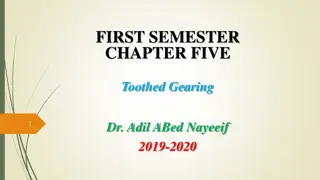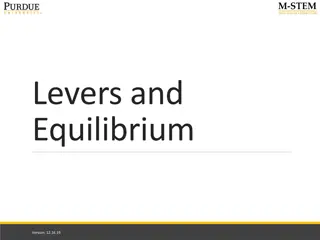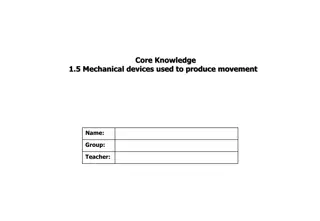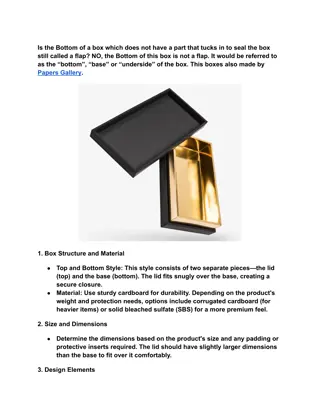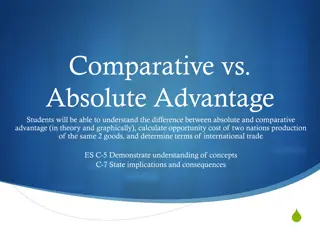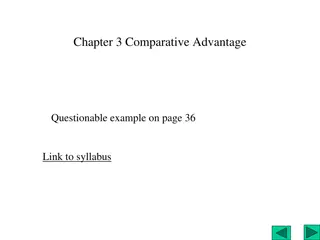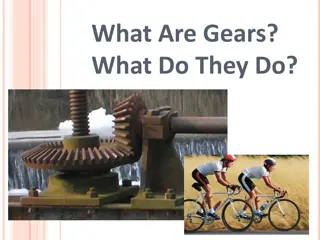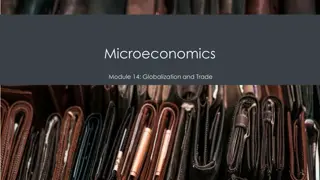Dive into Gears with the M.A.D. Box: A Mechanical Advantage Device
Unleash your engineering curiosity with the M.A.D. Box! Explore hands-on builds, delve into gear concepts, and test your creations. Learn about gears, gear meshing, and the intricate workings of the M.A.D. Box. Fuel your logical thinking and creativity as you embark on a gear-filled adventure in this interactive learning experience.
Download Presentation

Please find below an Image/Link to download the presentation.
The content on the website is provided AS IS for your information and personal use only. It may not be sold, licensed, or shared on other websites without obtaining consent from the author.If you encounter any issues during the download, it is possible that the publisher has removed the file from their server.
You are allowed to download the files provided on this website for personal or commercial use, subject to the condition that they are used lawfully. All files are the property of their respective owners.
The content on the website is provided AS IS for your information and personal use only. It may not be sold, licensed, or shared on other websites without obtaining consent from the author.
E N D
Presentation Transcript
M.A.D. Box A Mechanical Advantage Device (M.A.D.) in one little box!
Discover new hands-on builds and programming opportunities to further your understanding of a subject matter.
The Completed Look of the Build M.A.D.Box The M.A.D. Box build will be used for investigating gears and concepts related to gears.
Exploration Now that the build is finished, explore and see what it can do. Then answer these questions in your engineering notebook. The build uses two types of gears in its design. How many teeth are on each type of gear and what are these gears called? The VEX Super Kit also includes a 60 Tooth Gear. Why do you think it was not used in the build? How does the M.A.D. Box work? Explain with details.
Test your build, observe how it functions, and fuel your logic and reasoning skills through imaginative, creative play.
What are Gears? Gears Gears look like disks with teeth around their edges. It is important to notice that their teeth are equally spaced because gears work by having their teeth meshed together, as shown in the image above. When one gear turns, it turns the next one because their teeth are positioned between each other, which is known as being meshed. Gears are typically mounted, or connected to other parts, by a shaft or base. So gears are used to transmit rotary motion, or power, from one shaft to another. The shaft is usually positioned at the gear's center. In the image above of the VEX IQ Gears, the center hole to pass a shaft through is the square one because the IQ Shafts are square. One of the main ways to define a gear is by the number of teeth that it has.
Meshed Gears When two gears are meshed together, one gear turns the next. The gear that is doing the turning first is called the driving gear. The driving gear can be thought of as a type of input. The gear that is being turned by the first gear is called the driven gear. The driven gear is therefore the output. Watch the animation below to see meshed gears inaction. You should have noticed that the driving gear and driven gear turn in opposite directions. They have to spin in opposite directions because their teeth are meshed and they rotate at their centers. Gear Ratios A gear ratio is a comparison of the input (driving gear) to output (driven gear) and is calculated by considering each meshed gear's number of teeth. In the example above, the driving gear (input) and the driven gear (output) both have 60 teeth.
Here is the formula for calculating a gear ratio: Let's use the example of the two 60 Tooth Gears above because it's a simple ratio to calculate. The gear ratio of these two meshed gears is 1:1 which means each time the driving gear (input) turns one full rotation, the driven gear (output) also turns one full rotation. Mechanical Advantage Whenever two or more gears are meshed, a mechanical advantage is created within that build. Mechanical advantage is defined as the change of input force within a machine. The change can be measured by comparing the input and output. In the example above, the input and output have a 1:1 ratio so it might seem like there is no mechanical advantage but there actually is. The mechanical advantage when two gears are the same size is called power transfer because the driven gear and its shaft turn just as much as the driving gear and its shaft. So the driving gear (input) transferred all of its power to the driven gear (output). In the next activity, you will review your M.A.D. Box build and will calculate and test the mechanical advantages of speed and torque.
The M.A.D. Box's Gears 1. M.A.D. Box's Step 2: 12 and 36 ToothGears In Step 2 of the Build Instructions, the 12 Tooth Gear was already on the shaft that connected the M.A.D. Box's handle on that side of the build. Build Expert, find that side of the M.A.D. Box and show it to your teammates. Then demonstrate that when that handle is turned, the shaft turns the 12 Tooth Gear (driving gear - input) which then turns the 36 Tooth Gear (driven gear - output) that is being added in this step of the build. What is the gear ratio of these two gears? Calculator, figure out the equation below and have the Recorder check it. The 3:1 ratio tells us that the driving 12 Tooth Gear needs to turn three times in order to turn the 36 Tooth Gearonce. That leads to a mechanical advantage of torque. What is torque?
Torque is a mechanical advantage that makes the output of the driven gear or machine more powerful. In this case, the M.A.D. Box had three times as much input as output which makes it more powerful. Recorder, be sure to add notes to the engineering notebook about the mechanical advantage of torque within the M.A.D. Box.
2. M.A.D. Box's Step 10: 36 and 12 ToothGears In Step 10 of the Build Instructions, the other side of the M.A.D. Box was connected. It had a 36 Tooth Gear on the shaft with the handle. Build Expert, find that side of the M.A.D. Box and show it to the group. Then demonstrate that when that handle is turned, the shaft turns the 36 Tooth Gear (driving gear - input) which then turns the 12 Tooth Gear (driven gear - output). What is the gear ratio of these two gears? Calculator, figure out the equation below and then have the Recorder check it. The 1:3 ratio tells us that the driving 36 Tooth Gear only needs to turn one time to turn the 12 Tooth Gear three times. That leads to a mechanical advantage of speed.
Speed is a mechanical advantage that makes the output of the driven gear or machine faster. In this case, the M.A.D. Box has three times as much output as input rotations which makes it faster. Recorder, be sure to add notes to the engineering notebook about the mechanical advantage of speed within the M.A.D. Box. 3. M.A.D. Box's Compound GearRatios Build Expert, turn the handle connected to the 36 Tooth Gear slowly and let the group watch how fast the other handle turns. Recorder, after reading the description below, explain what a compound gear ratio is in the engineering notebook. The gear ratio for the 36 Tooth Gear turning the 12 Tooth Gear was 1:3 with the mechanical advantage of speed. But when you turn the handle connected to the 36 Tooth Gear once, the other handle turns many more than threetimes.
That is because the M.A.D. Box uses a compound gear ratio. The M.A.D. Box's compound gear ratio is created by having 36 Tooth Gears and 12 Tooth Gears share the same shafts. A compound gear ratio multiplies the mechanical advantage of speed or torque within a mechanism. The red arrows in the image above show the shafts that have both 36 Tooth and 12 Tooth Gears on them. Those shafts connect the first, second, and third gear ratios to each other. When the shaft turns, both the 12 Tooth and 36 Tooth Gears on the shaftturn. This multiplies the mechanical advantage created by each gear ratio because they are connected into a compound gear ratio. The M.A.D. Box has two compound gear ratios because you can give it input on either side - one leading to a torque advantage and the other leading to a speed advantage. To calculate the compound gear ratio on one side of the M.A.D. Box, we need to find the three gear ratios in the build from that input to the output, and then multiply them by each other. Build Expert, find the side of the M.A.D. Box where the input handle turns the 36 Tooth Gear and show it to the group. Hint: It is the handle at the bottom of the image above. Point out in the build to review where the three gear ratios are found.
Remember, all of the driving gears are 36 Tooth Gears and all of the driven gears are 12 Tooth Gears. Calculator and Recorder, complete and check the equations below: The entire team should try to answer the following questions: What does the 1:27 Compound Gear Ratio mean? When the handle with the 36 Tooth Gear is turned once, how many turns of the other handle should there be? The Recorder should organize the team's best answers and write them in the engineering notebook.
4. The M.A.D. Box's Compound Gear Ratio forTorque Build Expert, find the side of the M.A.D. Box where the input handle turns the 12 Tooth Gear and show it to the group. Hint: It is the opposite side of the M.A.D. Box as you were using above. Point out that when using this input handle, all of the driving gears are 12 Tooth Gears and all of the driven gears are 36 Tooth Gears. Calculator and Recorder, complete and check the equations below:
The entire team should try to answer the following questions: What is the Compound Gear Ratio and what does it mean? How many times do you turn the handle with the 12 Tooth Gear in order to turn the other handle once? The Recorder should organize the team's best answers and write them in the engineering notebook. 5. Thinking about the M.A.D. Box'sDesign Why aren't the M.A.D. Box's six gears all in one row? A design where all of the gears are meshed in a line is called a gear train. The image above shows the M.A.D. Box's gears as a gear train. A gear train like this only has one gear ratio and it is not a compound gear ratio. The ratio is either 1:3 or 3:1 depending on whether the first or last gear is the driving gear. Only the sizes of the first and last gears in this gear train matter to the gear ratio. The gears between the first and last gears are called idler gears. They do not increase the power or speed. Idler gears only change the direction of the rotation. Why wasn't the M.A.D. Box designed with only two gears: a small gear and a gear with 27 times more teeth?
The Compound Gear Ratio of the M.A.D. Box is 1:27 or 27:1. You might wonder why it wasn't designed with only two gears: the 12 Tooth Gear and a 324 Tooth Gear. That would have led to a 1:27 or 27:1 gear ratio. There are two reasons why the M.A.D. Box wasn't designed with a 324 Tooth Gear. The first reason is that a VEX Plastic 324 Tooth Gear doesn't exist. The largest gear in the kit is a 60 Tooth Gear. When engineers design builds, they need to take into account what materials are available and a 324 Tooth Gear was not available. The second reason is that a 324 Tooth Gear, if available, would be very large. A gear that size would make the build difficult to handle. The compound gear ratio makes better sense for designing a handheld device. When engineers design builds, they need to take into account how the device will be used by consumers.
Become a 21st century problem solver by applying the core skills and concepts you learned to other problems.
Where We've Seen Torque or Speed The chain and sprockets of a bicycle Pedal Faster or Pedal Stronger! When riding a bicycle, maintaining a certain pedaling speed (also called cadence) regardless of hills or flat road is important. To transfer power from the pedal to the wheels involves the usage of gears. There are two places that gears exist on a bicycle. The first is connected to the pedal, called the chainring. The second place is connected to the back tire, called the rear cog or sprocket. The gears are connected by a chain. The chain transfers the power applied at the pedal to the wheels and a mechanical advantage is created based on the size of gears connected to the pedals (front cassette) and wheels (rear cassette).
There are different bikes with varying numbers of gears called chainrings and sprockets. A single gear bike remains at a fixed mechanical advantage - the gears that are on a single gear bike will not change regardless if the person is pedaling on a flat road or a hill. This means the person pedaling has to put all of the strain on their legs in order to climb hills or ride much faster. A multi-geared bike allows the person pedaling to maintain the same pedaling speed to adjust their mechanical advantage to reach different outcomes. This enables the rider to climb hills or travel faster without changing their pedaling speed. A bicycle with multiple gears gives many options to use mechanical advantage to their personal advantage. A bicycle at a stand-still would want to use a gear combination suited for more torque (turning power) in order to accelerate from a stop or to climb a large hill. A mechanical advantage for torque (more turning power) is achieved when a smaller gear drives a larger gear. In the context of a bicycle, this happens when the smallest front chainring size is paired with the largest rear cog or sprocket. However, a bicycle geared for torque will not be able to move very quickly. On the other hand, a bicycle that is already moving and wants to reach a fast speed needs to use a gear combination suited for more speed (rate of motion) in order to achieve a high speed without having to pedal hundreds of times per minute. A mechanical advantage for speed is achieved when a larger gear drives a smaller gear. In the context of a bicycle, this happens when the largest front chainring size is paired with the smallest rear cog or sprocket. Having a mechanical advantage when biking allows riders to get the most out of the amount of energy they exert. A mechanical advantage can be applied in many different situations and become desirable when designing a robot for a competition.
Designing a Competition Robot for Torque or Speed ArmbotIQ Torque or Speed in Robotics Competitions Whether you build in a torque or speed advantage on your robot will depend on the weight of the objects it interacts with (how heavy the robot's part is, how much force it will need to do its task), and how quickly or carefully you want a task done (moving around the field vs. carefully grabbing and moving a game piece). It is helpful to consider using torque or speed advantages to accomplish tasks similar to these:
Moving the entire robot around the field - speed advantage Lifting and moving large robot arms or claws - torque advantage Controlling a claw to hold game objects firmly - torque advantage Moving a small part that collects small game objects - speed advantage It is important to read and consider the rules of a competition so that you can build a competition robot for speed and strength in a strategic manner.
Is there a more efficient way to come to the same conclusion? Take what you ve learned and try to improve it.
Calculating Two Gear Ratios Now that you have explored what gears are and how they can be used to create a mechanical advantage, you will now calculate different gear ratios and combine them to obtain a compound gear ratio. You will work in groups of four to calculate gear ratios and determine the resulting mechanical advantage. 6. View anexample Begin by viewing the following example: In the example above, the Resulting Ratio row refers to calculating the Compound Gear Ratio by multiplying all of the individual gear ratios together. Gear Ratio 1 has a 36 tooth-gear (36T gear) driving a 12 tooth-gear (12T gear). Viewing the relationship is Driven over Driving results in 12 over 36, which reduces down to one third. Thus, the ratio is 1:3. Similarly for Gear Ratio 2, a 60T gear is driving a 12T gear. Viewing the relationship as Driven over Driving results in 12 over 60, which reduces to one fifth. Thus, the ratio is 1:5. To combine these two ratios, fraction multiplication is introduced. One third times one fifth is one fifteenth. Keep in mind, when multiplying fractions, you multiply straight across in the numerator and denominator. Thus, the compound gear ratio is 1:15.
Once the compounded gear ratio is calculated, it can now be determined what the mechanical advantage is. The resulting advantage is Increased Speed: The 36T driving (input) gear will turn once for the 12T driven (output) gear to turn 15 times. 7. Calculation1 Fill in the missing calculations from the Gear Ratio table. Keep in mind, each person should be calculating according to their role. Role 1: Calculate the Gear Ratio 1 row of the above table. Show all work in your engineering notebook. Role 2: Calculate the Gear Ratio 2 row of the above table. Show all work in your engineering notebook. Role 3: Calculate the Resulting Ratio row of the above table. Check the calculations from Gear Ratio 1 and 2 before calculating the final compound gear ratio. Show all work in your engineering notebook. Role 4: Calculate the Advantage row of the above table. Show all work in your engineering notebook. All Roles: Once the table is completed, verify with all group members that the calculations are correct.
Calculating Three Gear Ratios Now that you have calculated a compound gear ratio from two gear ratios, we will now calculate a compound gear ratio from three gear ratios! You will work in groups of four to calculate gear ratios and determine the resulting mechanical advantage. 8. Calculation2 Fill in the missing calculations from the Gear Ratio table. Keep in mind, each person should be calculating according to their role. Role 1: Calculate the Gear Ratio 1 row of the above table. Show all work in your engineering notebook. Role 2: Calculate the Gear Ratio 2 row of the above table. Show all work in your engineering notebook. Role 3: Calculate the Gear Ratio 3 row of the above table. Show all work in your engineering notebook. Role 4: Calculate the Resulting Ratio row of the above table. Check the calculations from Gear Ratio 1, 2, and 3 before calculating the final compound gear ratio. Show all work in your engineering notebook. All Roles: Calculate the Advantage row of the above table. Show all work in your engineering notebook.
9. Calculation3 Fill in the missing calculations from the Gear Ratio table. Keep in mind, each person should be calculating according to their role. Role 1: Calculate the Gear Ratio 1 row of the above table. Show all work in your engineering notebook. Role 2: Calculate the Gear Ratio 2 row of the above table. Show all work in your engineering notebook. Role 3: Calculate the Gear Ratio 3 row of the above table. Show all work in your engineering notebook. Role 4: Calculate the Resulting Ratio row of the above table. Check the calculations from Gear Ratio 1, 2, and 3 before calculating the final compound gear ratio. Show all work in your engineering notebook. All Roles: Calculate the Advantage row of the above table. Show all work in your engineering notebook.
Understand the core concepts and how to apply them to different situations. This review process will fuel motivation to learn.
Review 1. Why was this build called M.A.D. Box? It was angry. o M.A.D. stands for Mechanical Advantage Device. o M.A.D. stands for Making Autos Drive. o None of these answers is correct. o 2. How many different sizes of gears did the M.A.D. Box build include? One o Two o Three o Four o 3. A gear ratio has two types of gears: a driving gear and a driven gear. Which of the following is the best definition of a driven gear? It turns first. o It is turned by the driving gear. o It is always smaller than the driving gear. o It is always larger than the driving gear. o 4. Which of the following best describes a gear ratio that has the mechanical advantage of torque? The driving gear is larger than the driven gear and speed is increased. o The driving gear is smaller than the driven gear and speed is increased. o The driving gear is larger than the driven gear and power in increased. o The driving gear is smaller than the driven gear and power is increased. o
5. Which of the following best describes a gear ratio that has the mechanical advantage of speed? The driving gear is larger than the driven gear and speed is increased. o The driving gear is smaller than the driven gear and speed is increased. o The driving gear is larger than the driven gear and power in increased. o The driving gear is smaller than the driven gear and power is increased. o 6. True or False: The M.A.D. Box can show both speed and torque advantages at the same time. True o False o 7. To see the M.A.D. Box's speed advantage, you turned which handle? The one that shared a shaft with the 36-toothed gear o The one that shared a shaft with the 12-toothedgear. o The one that shared a shaft with the 60-toothedgear o None of these answers is correct o 8. How are torque and speed advantages related to changing gears on a bicycle? Changing gears lets you pedal more easily or makes you need more force to pedal. o Changing gears lets your pedaling make you move farther or shorter distances. o Changing gears lets you pedal easily up steep hills or quickly across even surfaces. o All of these answers are correct. o 9. You should use gears in your robot to Create a torque advantage. o Create a speed advantage. o Create both torque and speed advantages, depending on the part of the robot and what it needs to do. o None of these answers is correct. o 10.What is this gear ratio when expressed as a reduced fraction?
3/1 o 1/3 o 5/3 o 1/12 o
Sliding Small Parts Along Shafts Using a beam to slide on a 12 Tooth Gear Use a Beam for Leverage You can use a 1x Beam for extra leverage to push small VEX IQ parts along shafts. Place the beam directly behind the small object and push on the beam to slide the object. This technique can also be used to slide parts onto or off of shafts.
Removing Standoffs from Mini Standoff Connectors Removal of a standoff from a Mini Standoff Connector How to Easily Remove Parts from Mini Standoff Connectors Standoffs and Mini Standoff Connectors can be separated by pushing a shaft through the Mini Standoff Connector. The same technique can be used for parts with similar ends in Mini Standoff Connectors, such as pins.
Mechanical Advantage This cart uses a wheel and axle system. Mechanical Advantage of Simple Machines Simple machines make work easier by creating mechanical advantage. Mechanical advantage is a measure of how much faster or easier a machine makes your work. Remember that work is a force - like a push or pull - that acts on an object to move it across a distance. For example, the cart in the picture above uses wheels and axles. Those wheels and axles give mechanical advantage because you can push the cart the same distance with less force than if it didn't have wheels and axles.
Rethink Section Roles Students can be organized groups of four students when engaging in the Rethink section. The following roles can be utilized if there are two independent gear ratios: Role 1 : This person will calculate the first row of the Calculation Table (Gear Ratio 1). Role 2 : This person will calculate the second row of the Calculation Table (Gear Ratio 2). Role 3 : This person will calculate the third row of the Calculation Table (Resulting Ratio). Role 4 : This person will determine the fourth and last row of the Calculation Table (Advantage). The following roles can be utilized if there are three independent gear ratios: Role 1 : This person will calculate the first row of the Calculation Table (Gear Ratio 1). Role 2 : This person will calculate the second row of the Calculation Table (Gear Ratio 2). Role 3 : This person will calculate the third row of the Calculation Table (Gear Ratio 3). Role 4 : This person will calculate the fourth row of the Calculation Table (Resulting Ratio). All Roles : The group together will collectively determine the fifth and last row of the Calculation Table (Advantage). If there are two students in each group, the students can each choose two roles. If there are three students in a group, one of the students can choose to do two roles. If there are four students in a group, each student can have one role. Provide the list of roles and their definitions to the students. Once students are in their groups, allow the members to choose their role. Circulate the classroom and makes sure that every student has a role. There is an optional collaboration rubric on this page. Remind the students of roles throughout the exploration. For roles to work, students have to feel as though they will be held accountable for fulfilling those roles. Therefore, interject if you see a student taking over someone else s role or not fulfilling their assigned role. Reminders about who is supposed to be doing what can be useful interventions.
Seek Section Roles Students can be organized groups of two to four students when engaging in the Seek section. The following roles can be utilized: Part Gatherer - This person ensures that the builders have all of the parts that they need for each step. Builder 1 - This person will build the first half of the M.A.D. Box (steps 1-5). Builder 2 - This person will build the second half of the M.A.D. Box (steps 6-10). Building Tips - This person ensures that the builders are not missing crucial pieces of information noted in the building tips for each step. If there are two students in each group, the students can each choose two roles. If there are three students in a group, one person can be the sole builder. If there are four students in a group, each student can have one role. Provide the list of roles and their definitions to the students. Once students are in their groups, allow the members to choose their role. Circulate the classroom and makes sure that every student has a role. There is an optional collaboration rubric on this page. Remind the students of roles throughout the exploration. For roles to work, students have to feel as though they will be held accountable for fulfilling those roles. Therefore, interject if you see a student taking over someone else s role or not fulfilling their assigned role. Reminders about who is supposed to be doing what can be useful interventions.












